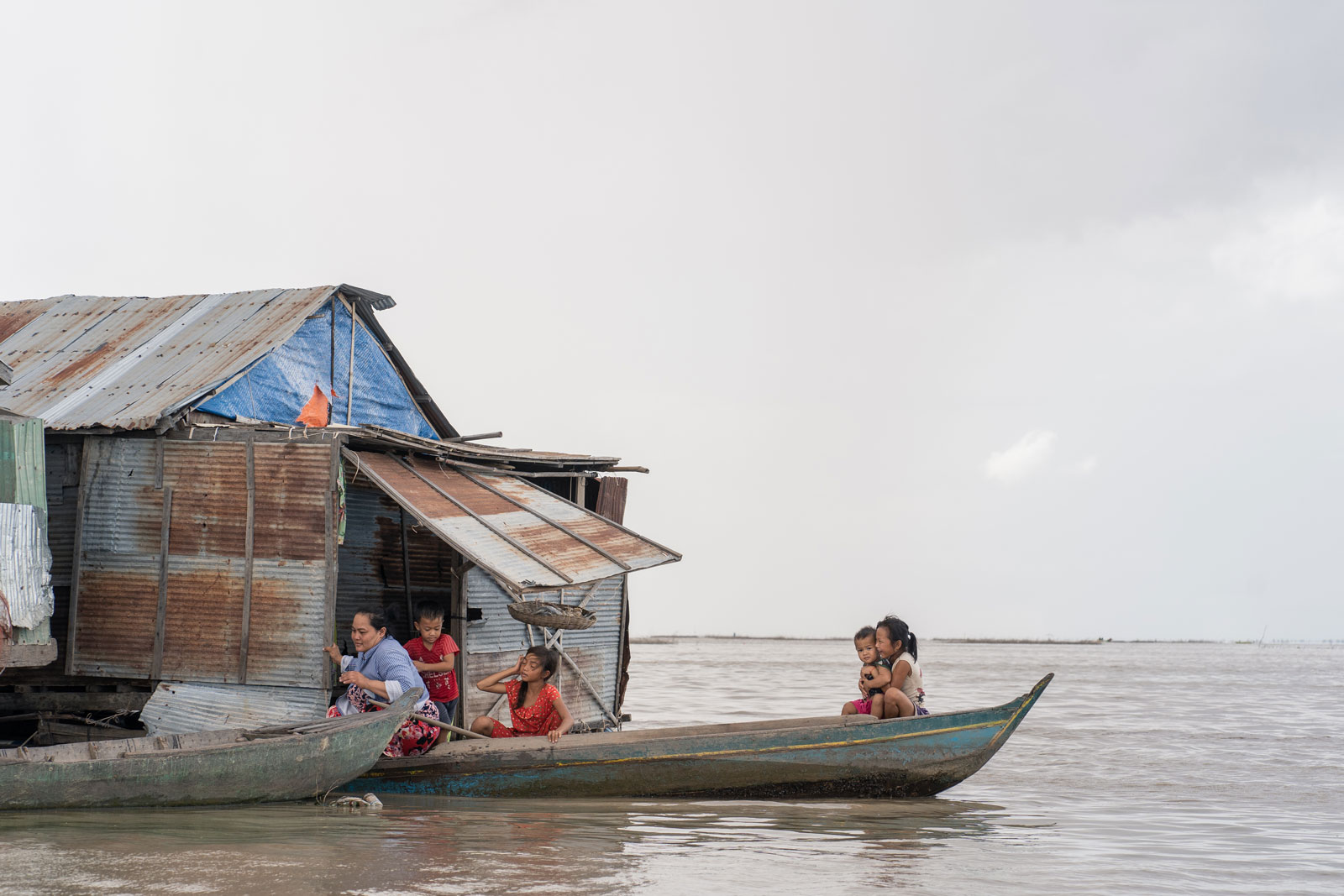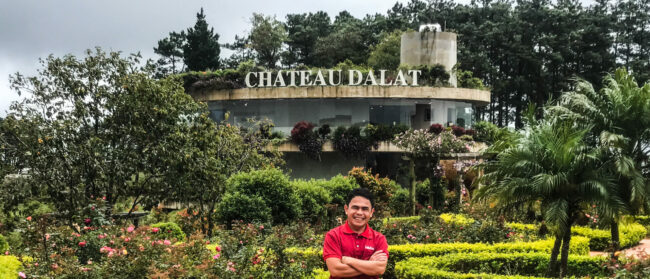This is a bonus feature in our five-part series, Cambodia in Quarantine, investigating the impact of the global pandemic on the four pillars of the Kingdom’s economy – garments, agriculture, construction and tourism. A pillar will be published each day on our website, while paying Globe members will receive early access to the full report in a special e-magazine. Sign up now to get all the stories today and support independent journalism from across Southeast Asia.
Additional reporting by Kong Meta
The farmers sat and waited in the middle of the brown, shallow waters of the Tonle Sap in pre-flood season.
A woman paddles a wooden boat to receive visitors, a rare outside contingent on the shores of the great lake known as Cambodia’s beating heart. Four children crowd on board and look out at the strangers.
The floating village is scattered on the surface, small houses dotting the water. The woman welcomes the visitors inside and, sitting on the gap-boarded floor, tells them about her life on the water. Below the floorboards can be seen the glistening backs of fish, scaly and black, rolling over one another, captives of a tiny farming operation bound to the house by way of a net slung under the water.
Inside the home is another woman, a neighbour, to whom three of the children belong. The neighbour’s house is tied to this one, but the families share space to make the most of their limited area. One of the women was born here, has spent her whole life living afloat. The other has been here for about a decade. Both are ethnically Vietnamese, part of a largely stateless, semi-nomadic Cambodian minority that has traditionally made a living on the waters of the Mekong.
It used to be easier out here, one of the women says. But this has been a terrible time for life on Cambodia’s great lake, and Covid-19 has almost nothing to do with it. The economic hardships of the Tonle Sap communities, particularly those on the lake itself, have been driven by environmental decay that predates the pandemic and which will likely persist long after medical researchers find solutions for the novel coronavirus.
While the pandemic downturn has not directly affected these people who had little stake before in the economy, it has further reduced their options at a time when their traditional way of life has all but dried up.

Chan Nikiv, 26, lives in a floating house on the Tonle Sap lake. While her husband goes out daily to fish, she raises their two children while farming fish under the house. Photo: Enric Català Contreras
When I was young, there were more fish and we could at least survive. Now, sometimes we have no food
Chan Nikiv
Sitting in front of a modest shrine, Chan Nikiv, 26, had little to say for her family’s fortunes.
“Of these last few years, this has been the hardest,” she said.
Chan picked up the thread next to her on the floor.
“We can’t even go to the market because it’s so muddy,” she said, holding her young son. “When I was young, there were more fish and we could at least survive. Now, sometimes we have no food. My husband goes to fish everyday and yesterday he caught two, but together they weighed less than a kilo.”

Upstream damming and climate change have slowed the flow of the Mekong into a trickle at places. The Tonle Sap, the biggest inland fishery in Southeast Asia, is fed each year by an unusual natural phenomenon, a reversal of current that causes the Mekong to flow back into the lake during the rainy season and flood it with life-giving waters. This event is likened to a heart pulsing with blood in a circulatory system and is so vital to the health of the lake that it is memorialised in Cambodian culture with the annual Water Festival, one of the Kingdom’s most revered holidays.
However, as the water levels of the Mekong dwindle with each passing year, the reversal of the flow grows weaker, jeopardising the fishing culture of Southeast Asia’s largest lake and the food security of the growing nation around it. About 60% of Cambodia’s national fish catch, about 770,000 tonnes, originates in the lake, which expands from a surface area of roughly 300,000ha in the dry season to as great as 1.3 million ha in the floods.
In early August, the Mekong River Commission (MRC), a multi-nation partnership that monitors the health and development of the river and basin, reported “extremely dry conditions” in the lake this year with the reverse flow at its lowest level since 1997.
Looking back to 2019, which had previously gone down as an exemplary low-water period for the lake and which has so far been surpassed in 2020, the MRC wrote the household fish catch in Kampong Chhnang province decreased by about 35% compared to the average over the previous eight years.
“Compared with the wettest or extreme flood year in 2013, the total fish catch has decreased by about 50%,” the report stated. “The significant delay and lower reverse flows in 2020 may further reduce the fish catch in Cambodia, leading to reduced food security for the most vulnerable peoples in the country and in the region.”

Without water, Kampong Khleang lies dry while the fishermen have to follow the receding shorelines of the Tonle Sap lake. Photos: Enric Català Contreras


When there’s too much water, we worry … But when there’s not enough, we also worry
For the fisherfolk of the big lake, each day of July rolled into another as featureless as the flat expanse of shallow water. On a tributary of the lake, where communities of stilted wooden houses can rise 12 metres above the dry ground below, the boats of local anglers were stuck in the mud as late as mid-month, their access canal to the Tonle Sap reduced to a puny trickle.
A woman sitting at a small general store in front of her home says the boats were able to float by the end of July 2019, bad as that year had been. By October of that year, she added, pointing about chest-high to a wooden post, the water had risen so high it had flooded her shop.
“When there’s too much water, we worry,” she said. “But when there’s not enough, we also worry … Now, we’d be more hopeful if there was water.”
As the catch of fish has grown smaller, she said, many of the fisherfolk have had to look for other work. Some go into construction, while others ply their labour wherever else it’s needed.
Across the street from the woman’s shop, Sean Soung, a 60-year-old fisherman, was sitting beneath his stilted home, lounging on a hammock over the dry, sandy earth. Around him hung nets, traps and various tools of his trade as a prawn fisherman; tiny clamshells littered the ground.
“Last year around mid-July, I was able to start fishing,” said Soung. This year, however, there’s been no such luck. Even when he can get out on the water, he explained, each year the catch has grown smaller, both in terms of the haul and in the individual creatures.
Fishermen, in response to the ecological degradation of the lake, have used progressively tighter-woven nets in a bid to catch the younger, smaller animals, thus feeding the cycle of collapse.

Soung remembers the first time he went out on his father’s fishing boat at the age of 12, when people could make a decent living from the bounty of the waters. Now, reflecting from the shade of the home in which he’d invested so much money to stilt above the sandy flats more than two decades ago, he said he’d quit fishing for good if he wasn’t so old.
“I think 100% of us here are very worried,” Soung said. “Everywhere we go, we talk about the low water, but what can we do? As human beings, we need to be resilient. Here, we’d need to become labourers, because in this commune, without water, we can’t do much, neither fishing nor farming.”
But, as have the waters, so too have fallen the prospects of finding work outside the commune. The World Bank has projected this to be the worst year in decades for the Cambodian economy, which may contract by as much as 5%.
Such terms may be of little significance to those adrift on the great lake and, for the families of Nikiv and Ming Triv Ghay, 38, the pandemic conditions have made essentially no difference to their meagre livelihoods. Even if they had money, Chan and Ming said they’d barely be able to make it to market with the water being as low as it was.
Not far from their village, at least a few kilometres from shore, men stood up to their waist in the brown water, slowly dragging nets. In the homes of Ming and Chan, the prospects for the rest of this year are riding squarely on the crop of fish writhing under the floorboards. The outlook is increasingly bleak.
Ming said the families have about 1,000 fish, give or take, that might be ready for market about January of next year.
“We’re not sure how much we’ll get for them because they keep dying,” she said. The families have eked out some calories by scooping out the dead and eating them.
Ming had no illusions about the venture.
“We are hopeless here,” she said. “Totally hopeless.”


